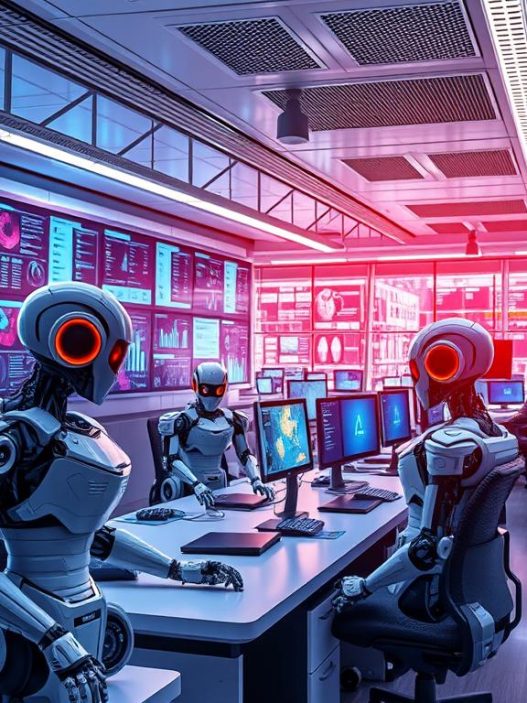Understanding the ROI comparison traditional vs AI powered customer service is now essential. Businesses aim to boost their customer service. Traditional methods focused on cutting costs, less on making customers happy. But, AI changes the game. Already, 63% of organizations invest in AI. It offers both savings and increased revenue through better customer experiences.
Using virtual agents can reduce handling times and employee turnover. They also save money and enhance customer happiness. These systems are available 24/7, handle routine tasks, and offer personalized experiences. This builds loyalty and encourages more purchases. The difference in ROI between traditional and AI customer service is important to understand. We need to have clear expectations of what AI can do now and in the future.
Key Takeaways
- Traditional customer service ROI has focused mainly on cost savings.
- AI solutions provide both cost reduction and revenue generation opportunities.
- Virtual agents enhance customer experience, leading to increased loyalty.
- Realistic expectations are essential for understanding AI implementation outcomes.
- Successful AI strategies require a focus on customer journeys and training investment.
Understanding Traditional Customer Service ROI
Traditional customer service leans on human contact. This approach strengthens customer bonds. Customer loyalty and retention help gauge the return on investment (ROI) in these methods. Human agents manage queries but this involves high labor costs and the need for training. However, the high-quality support they provide fosters deep customer relationships.
Cost Efficiency in Traditional Methods
The upfront costs of training and keeping staff are notable. Yet, many businesses find these expenses worthwhile due to the personalized experiences created. In the US, a customer service agent’s average hourly wage, including salary, recruitment, and training costs, varies between $30 and $40. Firms committed to traditional customer service often see stronger client connections, boosting their financial outcomes.
Limitations of Traditional Customer Service
Traditional customer service does have its downsides. It’s not easy to scale up, and heavy demand can cause slow responses and inconsistent service. A flood of queries might lower the quality of customer interactions, leading to unhappiness. These issues highlight the importance of evaluating traditional customer service costs thoroughly. Without modern tech, keeping consistent service quality in various scenarios is tough.
| Aspect | Traditional Customer Service | AI-Powered Customer Service |
|---|---|---|
| Response Time | Slower due to human involvement | Instant and consistent |
| Scalability | Limited during peak times | Highly scalable with automation |
| Cost Efficiency | High ongoing labor costs | Lower operational costs through automation |
| Personalization | Strong human touch | Data-driven and continuous learning |
Evaluating AI Customer Service ROI
To understand the ROI of AI customer service, we need to look at a few things. These include its speed, how efficient it is, its ability to generate revenue, and its impact on how happy customers are. AI tools like chatbots make businesses more efficient in handling customer interactions. They make the service faster and better.
Speed and Efficiency Improvements
AI boosts the speed and efficiency of serving customers. Most customer questions are simple and AI can handle them fast. This leads to shorter wait times. A skincare company, NØIE, saw an 89% drop in how long it took to reply to a customer with AI. This shows how important AI can be for a company’s efficiency.
Revenue Generation through AI
AI can also help companies make more money. It helps sell more products and find good leads. AI virtual assistants work all day and night. This means they can sell products even after hours. Bank of America’s Virtual Financial Assistant, Erica, has had over 1.5 billion talks with customers, helping the bank earn more. This is a good example of how AI can increase a company’s profits.
Customer Satisfaction Metrics
AI helps make customers happier with the service they get. This leads to better performance for the business. Companies that use AI see better scores in how satisfied customers are, how likely they would recommend the company, and how easy it was for them to get help. A huge 98% of Bank of America’s customers liked using their automated chat. This shows that AI can make customers more loyal, which is good for the business.
| Metric | Traditional Customer Service | AI Customer Service |
|---|---|---|
| Response Time | Average 10 min | Average 1 min (89% improvement) |
| Customer Satisfaction Score (CSAT) | 70% | 98% |
| Operational Hours | 9-5 | 24/7 |
| Upselling Success Rate | 10% | 20% |
| Cost of Operation | High | Lower due to automation |
ROI Comparison Traditional vs AI Powered Customer Service
Companies looking into traditional vs AI customer service need to track performance closely. They use key performance indicators (KPIs) for a deeper look into service quality. These metrics, like response times, satisfaction levels, and sales numbers, show how well each method works.
Key Performance Indicators to Measure
Finding the right KPIs is key to understanding customer service success. These indicators track how quickly and effectively teams help customers:
- Average Handle Time (AHT): This shows how long it takes to sort out customer issues, affecting service speed.
- Customer Satisfaction Score (CSAT): This measures how happy customers are after getting help, showing the quality of service.
- First Contact Resolution (FCR): This looks at solving problems on the first try, keeping customers happy.
- Sales Conversion Rates: This checks if customer service helps make more sales.
Cost Analysis: Traditional vs AI-powered Solutions
Comparing costs shows big differences between AI and old-school customer service. Traditional methods cost more due to hiring and training people. But, AI services make operations smoother, cutting down on extra work and saving money.
The savings from using AI can be between 20-28%. This makes AI a smarter choice in the long run. Also, despite higher early costs, the benefits of AI, like insights and efficiency, make it worth it. So, when firms look at AI vs traditional service, they should think about not just costs. They should also consider how it can make things better for customers.
Benefits and Challenges of AI-Powered Customer Service
AI-powered customer service changes how companies and customers talk to each other. It brings big benefits of AI customer service, like better work and new insights. This means companies can do their job better and learn more.
Advantages of Implementing AI Solutions
Using AI in customer service has several important benefits:
- Improved Accuracy: AI can quickly and correctly analyze data, giving better answers to what customers ask.
- Rapid Response Times: AI helps answer questions fast, offering help right away.
- Handling Large Volumes: AI can talk to many customers at once, making sure everyone gets help fast, even when it’s busy.
- Data Insights: Companies learn valuable info from what AI talks about with customers. This helps them connect better with people.
- Cost-effective Operations: AI helps answer simple questions by itself, cutting down on costs and making businesses more money.
Challenges in Adopting AI Technologies
Even with clear benefits, there are big challenges in adopting AI technologies:
- Data Privacy Concerns: Customers want to know their information is safe. They worry about privacy with AI systems.
- Integration Issues: Putting AI into current systems takes time and money. This can also cause problems with the service sometimes.
- Maintaining Quality Interactions: AI doesn’t understand feelings, which can make some customer talks not go well.
- Job Displacement: With AI doing more work, some jobs for people might not be needed. This means they need new skills.
- Initial Investment Costs: Starting with AI can be expensive. You need the right equipment and software. The investment must pay off.
Companies starting with AI customer service have a lot to think about. They need to balance the good benefits of AI customer service against the tough challenges in adopting AI technologies. As AI gets better, businesses have to keep up to make sure customers are happy and the company grows.
Conclusion
The comparison between traditional and AI customer service shows they handle customer interactions differently. Each has its own advantages and challenges. AI customer service is gaining popularity because it offers efficiency, boosts revenue, and makes customers happier. This works best when done thoughtfully. On the other hand, traditional service is great for personal touches that many customers like.
Organizations must think carefully when choosing between traditional and AI solutions. They need to consider what their customers want, how ready they are for technology, and their long-term goals. Now, more companies see the value in AI. In fact, 74% of them say their customer service AI has paid off.
A mix of both traditional and AI services might be the best plan. This way, companies can respond quickly using AI but also keep the personal connection customers appreciate. Being flexible and ready to adapt may help businesses succeed in a market that always changes.



